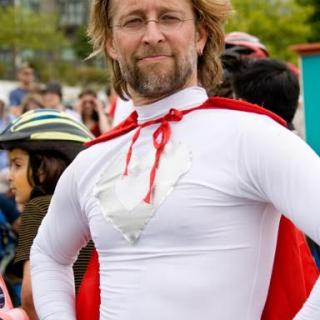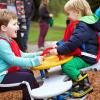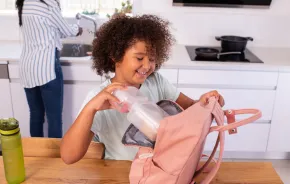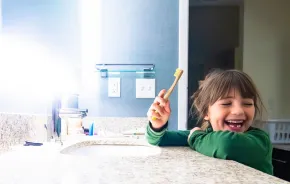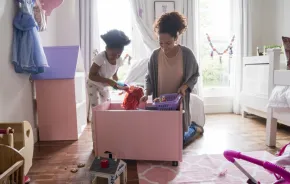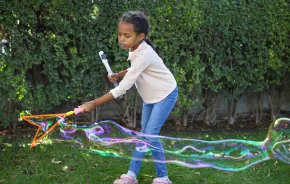Editor's note: This article was reprinted with permission from Teacher Tom's Blog.
Not long ago, one of the readers of my blog asked, "If I have $200 to make my backyard look a little more like your school, what should I get?"
Like play?
We've got a whole issue devoted to it. Play on.
First off, $200 is a pretty good budget for a project like that, mainly because we acquired most of the coolest stuff in the outdoor classroom at Woodland Park Cooperative School at little or no cost.
So here are some suggestions:

Full-body sandpits: sandboxes are great, but they're often really too small and too shallow for growing kids. When our community has created playgrounds, we always talk about "full-body" sand pits. Sand, while not terribly expensive (around here we get about 60 lbs. for $3) could eat up that whole budget, however, but setting aside a digging area involving just regular dirt is an acceptable alternative.
Shovels and pails: And, of course, you'll need shovels, pails and other tools. We use cheap plastic ones. We've tried metal, but galvanized steel buckets are heavier when full and tend to get bent out of shape quite easily in our rough-and-tumble environment. We do own some metal shovels, rakes and hoes, but they aren't for day-to-day use even though they would probably make the work go easier. The reason is that our shovels are as often used as "weapons" as for digging, and while they both hurt, getting accidentally brained by a plastic shovel is generally preferred over being brained by a metal one.
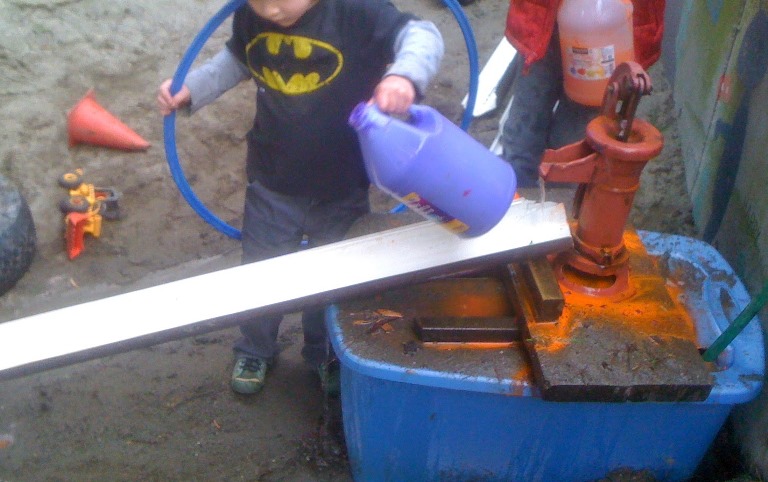
Water pump: Our two-level sandpit wouldn't be itself without a cast iron water pump. You can get a new one for under $50. Ours is mounted on a board that rests atop an inexpensive 30-gallon plastic tub that serves as our cistern. We drilled holes in the lid for the uptake pipe and for a hose to refill it when it's empty.
Gutters: A natural extension of the pump, of course, are lengths of guttering. Ours are cut into six-foot sections although we have a couple 10-footers stashed away for special uses. If you spend more than $200 on a pump set up, you've spent too much.
Using the gutters as loose parts is much preferred over a permanent installation. Not only does that allow kids to change the direction and flow of water as their needs demand, but we can use the gutters for other purposes, like down at the art station where we employ them in painting on adding machine tape with balls, mini-pumpkins, and/or toy cars and trucks.
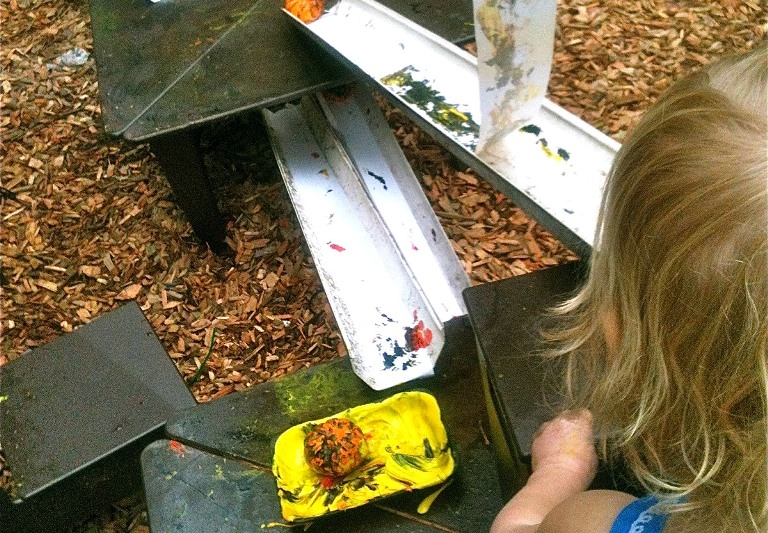
Logs and tree rounds: Much of the stuff that makes our space "look" the way it does are things on which you really shouldn't have to spend anything. You can usually pick up logs and tree rounds, for instance, from a neighbor who has recently removed a tree or done some major pruning. Tree services will often give you some if they know it's for kids.
Our two boats have both been donations. You just have to get the word out and wait.
It's important to remember, I think, that nothing lasts forever. It's good for kids to spend time playing on, with, and around things that are in various stages of deterioration. So when we got our new metal boat, we simply left the old rotting wooden one in place, where it is slowly "sinking" into the sand.
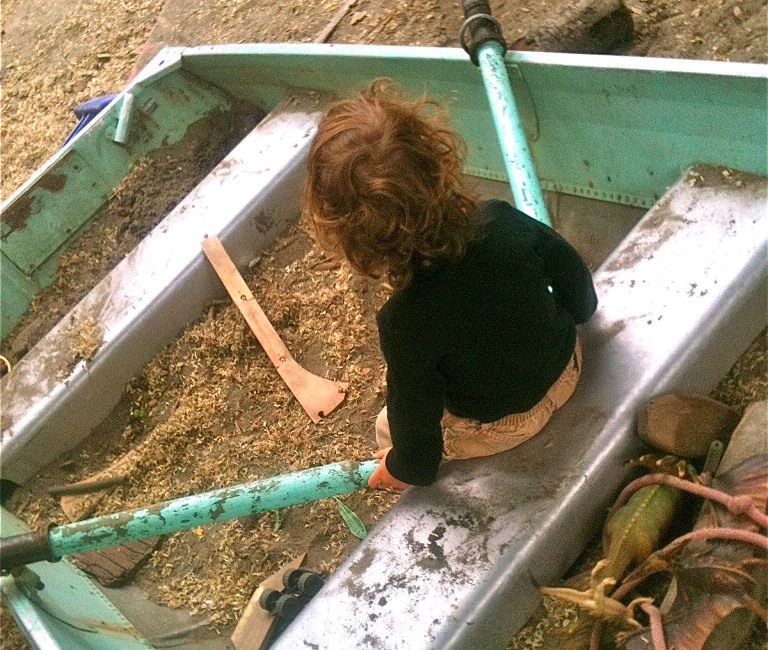
Lots of loose parts: And speaking of loose parts, you shouldn't have to spend a penny on those.
Most of the toys, broken things, cartons, containers, boxes and whatnot that we're ready to toss out, spend at least a little time in the outdoor classroom before reaching their final resting place in the dumpster.
"Loose parts" is just another name for junk.
Counted among our favorite loose parts are those larger bits that can be hoisted about by teams of kids.
Planks are incredibly versatile. Ours range in length from 4-8 feet. These have all been donated by families and others looking to make space in their garages.
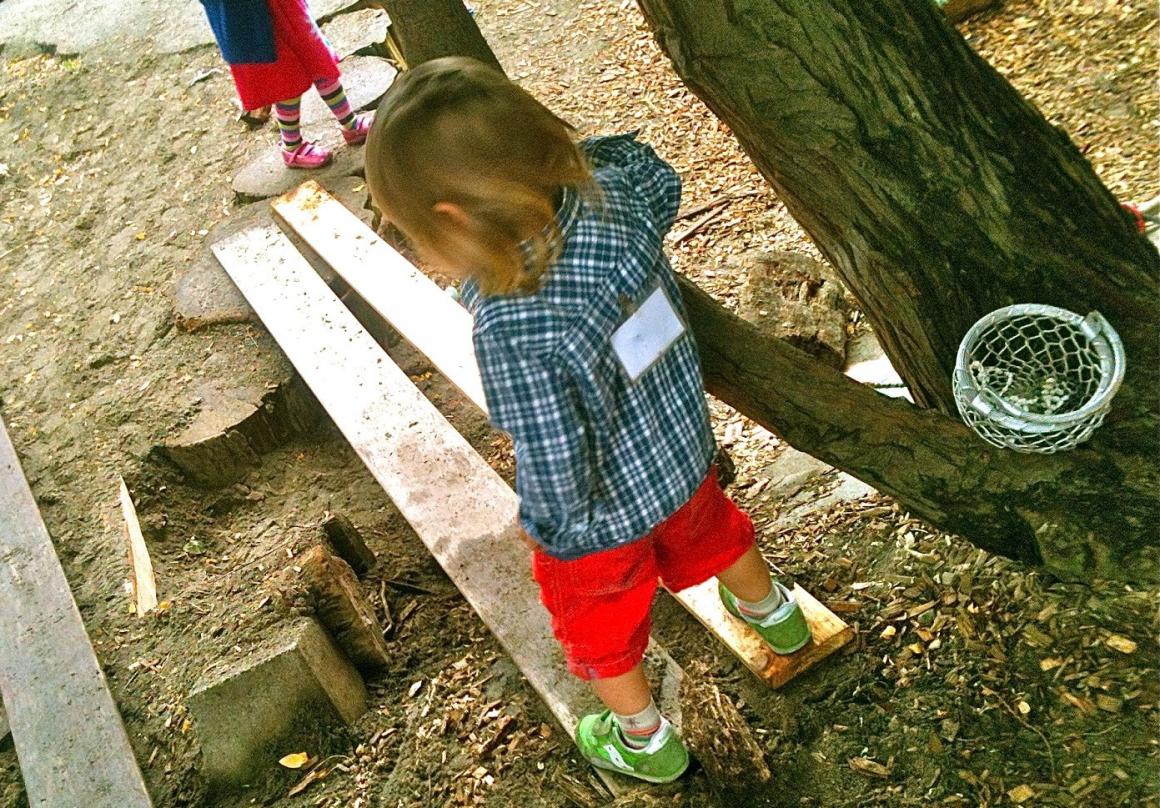
It's best if you can get new wood without a lot of knots in it: Kids really like to experiment with the springy nature of the planks. Some of these have lasted us three-plus years of being outdoors year round.
Shipping pallets are a great addition to planks. Ours were all acquired for free. We used to just grab them from the side of the road, but since learning that there can be some chemical and biological hazards associated with pallets, we've started making sure to only use those that are stamped with "HT," which stands for "heat treated." You don't want the chemically treated pallets around kids. We also avoid pallets that have been used to transport food products.
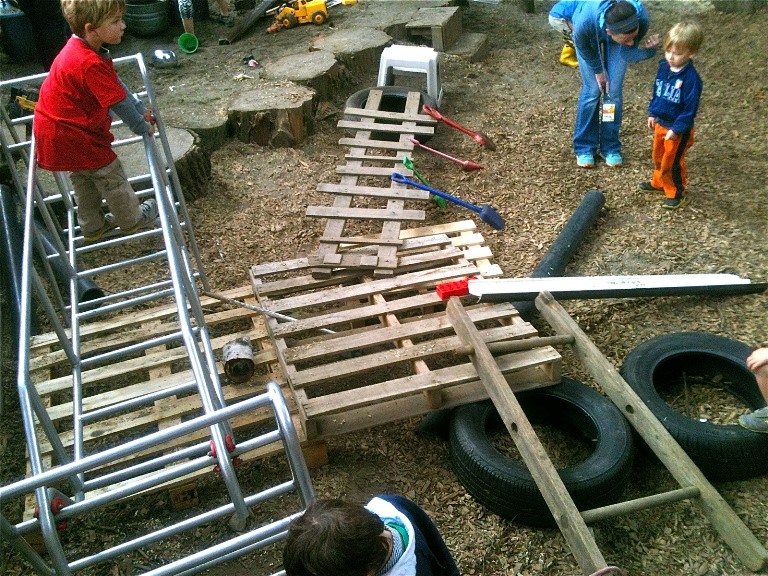
Old car tires are also staples around our place.
And we have a couple of galvanized steel garbage cans. They not only make great, loud, "thunder drums" and hidey-holes, but we often commander them as impromptu table tops.
Other free and inexpensive things we like to have around include ...
- Ropes
- Pulleys
- Chains
- Roles of plastic fencing
- PVC pipe
- Old bicycle inner tubes
- Pipe insulation
- Cardboard boxes
- Hoops
- Stick ponies
- Chalk
- Lots of stuff to just bang on
As far as more permanent things, I think it's nice to have some sort of playhouse. Again, ours was a donation from a family whose kids had outgrown it, although one of our grandfathers is building us a new one as we speak. A playhouse can be as simple as a cardboard box, however.
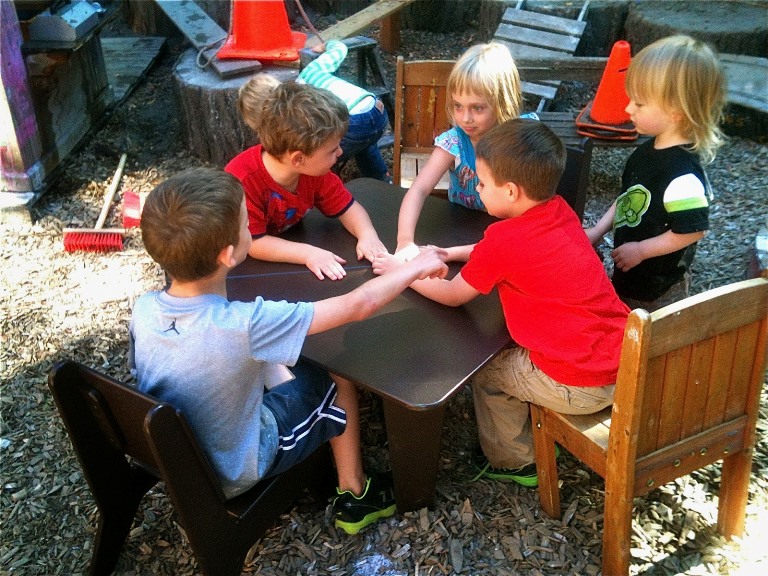
It's also nice to have some sturdy tables and chairs. We've purchased ours and they were quite a bit outside the $200 price range, but that's because we're a preschool with over 65 kids playing out there every day. Cheaper stuff, and even cast-off items with the legs cut down, will work for backyard purposes. You can often find workable stuff at Goodwill.
And our space simply would not be what it is without a garden. Ours is just a collection of raised beds, but you don't even need that.
Pots, soil and a few seeds will suffice.
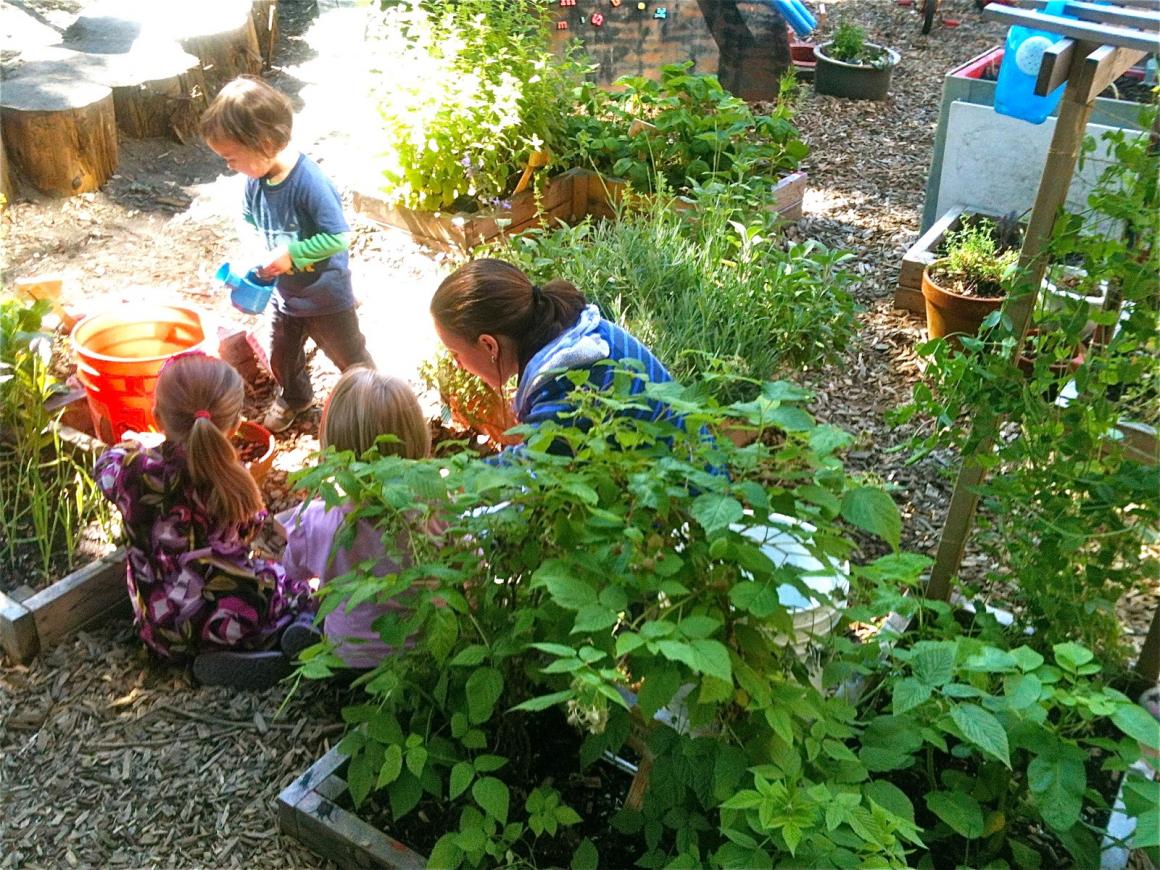
We've also re-purposed an old sensory table as a compost/worm bin.
None of these things are expensive and that's how a child's play space should be. If there is any great truth about an outdoor classroom, it's that it should be continually evolving and adapting, a hodge-podge of old and new and everything in between. I am not exaggerating when I say that we acquired everything discussed in these photos for not a lot more than $200, other than the furniture and the sand, although there are work-arounds for both of those. If you're just outfitting a backyard, you can probably do it all for less.
That said, it's a backyard, which implies neighbors. As educational as these kinds of spaces are for children, these wonderlands of loose parts, dirt, rocks and compost, these bastions of junkyard chic, they are often perceived as eyesores by the uninitiated. So before going too far, you might want to save up to build a fence.
|
Note: Tom Hobson has just published a book, Teacher Tom's First Book. |




